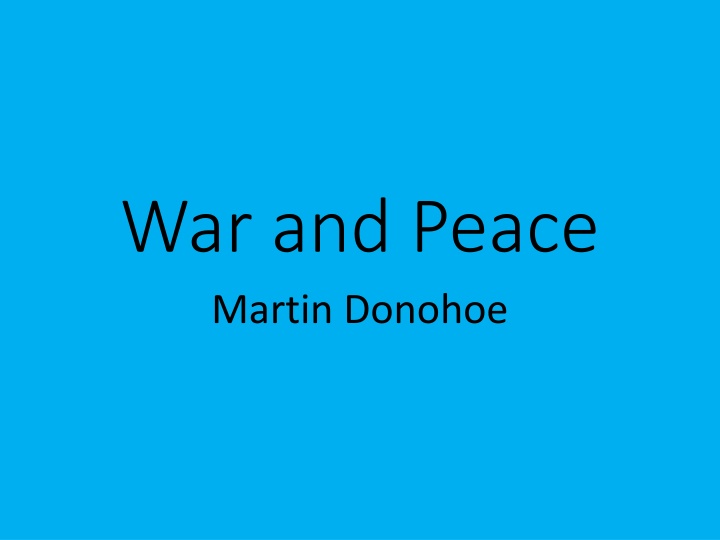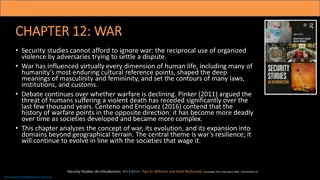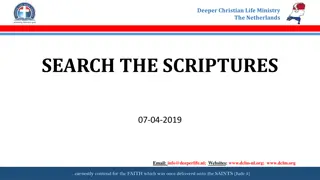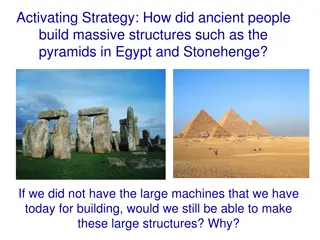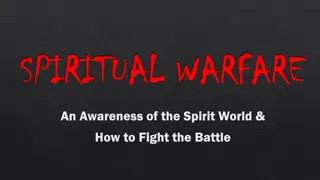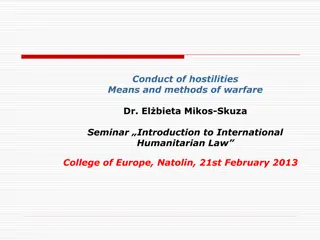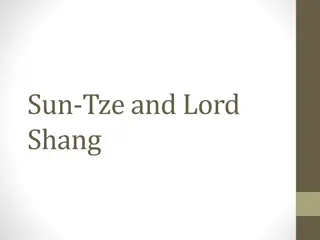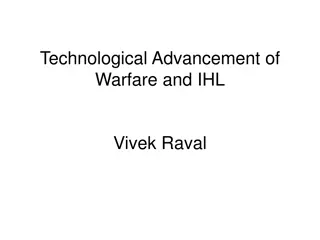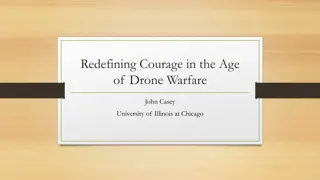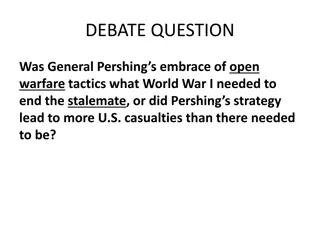The Evolution of Warfare: From Ancient Times to the Modern Era
Explore the historical progression of organized warfare, from the beginnings of large-scale conflicts and the development of weapons to the impact of militarism on society. Discover how warfare has evolved over millennia, leading to the complex landscape of 20th and 21st-century warfare. Delve into the factors that fuel wars and the contrasting effects of militarism, shedding light on the complexities of human conflict throughout history.
Download Presentation

Please find below an Image/Link to download the presentation.
The content on the website is provided AS IS for your information and personal use only. It may not be sold, licensed, or shared on other websites without obtaining consent from the author.If you encounter any issues during the download, it is possible that the publisher has removed the file from their server.
You are allowed to download the files provided on this website for personal or commercial use, subject to the condition that they are used lawfully. All files are the property of their respective owners.
The content on the website is provided AS IS for your information and personal use only. It may not be sold, licensed, or shared on other websites without obtaining consent from the author.
E N D
Presentation Transcript
War and Peace Martin Donohoe
Am I Stoned? A 1999 Utah anti-drug pamphlet warns: Danger signs that your child may be smoking marijuana include excessive preoccupation with social causes, race relations, and environmental issues
Beginnings of Large-Scale, Organized Warfare 10,000 yrs ago agriculture Expanding populations Hierarchical society Division of labor Ruling Class Artisan Class Warrior class Subjugation of women Infectious/chronic diseases Private property, Money
Weapons of War 3500 yrs ago bronze weapons and armor 2200 yrs ago iron 1900 yrs ago widespread use of horses
Weapons of war Ninth Century China - bombs Thirteenth Century China rockets Forgotten until the 19thCentury 1783 Balloon
Weapons of war 1903 Airplane Hiroshima, August 6, 1945 15 kiloton bomb, 140,000 deaths The day that humanity started taking its final exam Buckminster Fuller Nagasaki, August 9, 1945 22 kiloton bomb, 70,000 casualties
20th/21stCentury Warfare Small arms Landmines Nuclear weapons Chemical and biological weapons Weaponization of space Nanotech weapons Robotic soldiers Cyberwarfare
Militarism Fuels Wars Positively correlated with: Conservatism Nationalism Religiosity Patriotism Authoritarianism
Militarism Fuels Wars Negatively correlated with: Respect for civil liberties Tolerance of dissent Democratic principles Sympathy and welfare toward the troubled and poor Foreign aid for poorer nations Subverts other societal interests (health, environment, education, social programs)
Hermann Goering (at the Nuremberg Trials, shortly before being sentenced to death) Of course the people don't want war. But it is the leaders of the country who determine the policy, and it is always a simple matter to drag the people along, whether it is a democracy, or a fascist dictatorship, or a parliament, or a communist dictatorship . . .
Hermann Goering Voice or no voice, the people can always be brought to the bidding of the leaders All you have to do is to tell them they are being attacked, and denounce the pacifists for lack of patriotism and exposing the country to danger.
Epidemiology of Warfare: Rising Casualties, Especially Among Civilians Deaths in war: 17thCentury = 19/million population 18thCentury = 19/million population 19thCentury = 11/million population 20thCentury = 183/million population Increasing casualties to civilians 85-90% in 20thCentury (vs. 10% late 19th Century)
Contemporary Wars 250 wars in the 20thCentury Incidence of war rising since 1950 Most conflicts within poor states Over 30 separate civil wars currently underway Most involve U.S.-supplied weapons
Josef Stalin The death of one man is a tragedy. The death of millions is a statistic.
Legacies of Colonial Exploitation Christopher Columbus log entry upon meeting the Arawaks of the Bahamas: They brought us many things They willingly traded everything they owned They do not bear arms They would make fine servants With fifty men we could subjugate them all and make them do whatever we want.
Legacies of Colonial Exploitation Winston Churchill (speaking in favor of RAF s experimental bombing of Iraqis in 1920s, which killed 9,000 people with 97 tons of bombs): I am strongly in favor of using poisoned gas against uncivilized tribes to spread a lively terror against recalcitrant Arabs as an experiment
Legacies of Colonial Exploitation Cecil Rhodes (Rhodesia now Zimbabwe, Rhodes Scholarship, DeBeers Mining Company): We must find new lands from which we can easily obtain raw materials and at the same time exploit the cheap slave labour that is available from the natives of the colonies. The colonies would also provide a dumping ground for the surplus goods produced in our factories.
John Wayne I don't feel we did wrong in taking this great country away from them. There were great numbers of people who needed new land, and the Indians were selfishly trying to keep it for themselves.
Consequences of War Deaths, injuries, physical and psychological sequelae Famine Collapse of health care system affecting those with acute and chronic illnesses
Displaced Persons 66 million forcibly displaced persons worldwide Refugees, internally-displaced person, asylum seekers Approximately of world s refugees are hosted by developing countries
Consequences of War Environmental degradation Increasing poverty and debt Increasing social, legal, educational, and political marginalization of women Torture and repression of freedom of expression All lead to recurrent cycles of violence
Were Number One U.S. #1 in military spending #17 in education #26 in infant mortality #35 in life expectancy and overall health
Dwight Eisenhower The problem in defense spending is to figure out how far you should go without destroying from within that which you are trying to protect from without
Social Injustices 29 million Americans lack health insurance (resulting in 28,000 deaths/yr) 22% of US children live in poverty Homelessness, public educational system a shambles, increasing jail populations, etc. Mass extinction, global warming 2.5 billion people worldwide live in abject poverty (earn less than $500 per year, lack access to clean drinking water)
Social Injustices 650 million people lack access to clean drinking water 2.3 billion lack adequate sanitation services 21,000 people starve to death daily (1 Hiroshima/7 days)
Overconsumption (Affluenza) U.S. = 4.5% of world s population Owns 50% of the world s wealth U.S. responsible for: 25% of world s energy consumption 33% of paper use 72% of hazardous waste production
Maldistribution of Wealth Richest 1% own 46% of the world s wealth Top 62 billionaires worldwide worth $1.8 trillion, the combined income of bottom 3.5 billion people (1/2 of world s population)
Maldistribution of Wealth U.S: Richest 1% of the population owns 40% of the country s wealth Poorest 90% own 30% Widest gap of any industrialized nation
Income Inequality Kills Higher income inequality is associated with increased morbidity and mortality at all per capita income levels
Environmental Destruction 400,000 deaths/yr worldwide from global warming (expected to double by 2030) (UN) U.S. farm workers suffer up to 300,000 pesticide-related acute illnesses and injuries per year; 25 million/yr wordwide (EPA) Pesticides in food could cause up to 1 million cancers in the current generation of Americans (NAS) 1,000,000 people killed by pesticides every 6 years (WHO); 200,000 deaths/yr worldwide (UN) almost all in developing world where use of obsolete pesticides is common
Environmental Consequences of Militarization World s single largest polluter 8% of global air pollution 2-11% of raw material use Almost all high and low level radioactive waste
The US Military Owns an amount of land equal to North Korea or Kentucky (25 million acres) Much of it polluted Cleanup cost estimates in the hundreds of billions
Health Costs of Militarization 3 hours of world arms spending = annual WHO budget day of world arms spending = immunization for all the world s children 3 days of US arms spending = amount spent on health, education and welfare programs for US children in one year
Health Costs of Militarization 3 weeks of world arms spending = primary health care for all in poor countries, including safe drinking water and full immunizations Brain drain: 2/3 of US scientists work in military-industrial complex (similar in Russia during cold war; much work has widespread applicability)
Skewed Priorities The world spends $1.8 trillion/year on military goods and services For 25% of this, we could: Eliminate starvation and malnutrition Provide shelter for all Eliminate illiteracy Provide clean and safe water Prevent soil erosion
Skewed Priorities Prevent global warming Stop deforestation Aid all refugees Retire developing nations debt Provide clean, safe energy (through efficiency and renewables)
Skewed Priorities Prevent acid rain Fix the ozone hole Stabilize world population Provide basic universal health care and AIDS control Eliminate nuclear weapons and land mines
Dwight Eisenhower Every gun that is made, every rocket fired, signifies in the final sense a theft from those who hunger and are not fed, those who are cold and not clothed
Martin Luther King A nation that continues year after year to spend more money on military defense than on programs of social uplift is approaching spiritual death.
The US: Rogue Nation History: Native Americans, slavery, current excesses, disparities and injustices Co-opting Nazi and Japanese WWII scientists Minimum 277 troop deployments by the US in its 240 year history
The US: Rogue Nation Over 1,000 bases worldwide today (737 in 69 other countries) All other countries combined occupy only 30 foreign bases 54 countries helped facilitate CIA s secret detention, rendition, and interrogation program
The US: Rogue Nation Since the end of WWII, the US has bombed: China, Korea, Indonesia, Cuba, Guatemala, Congo, Peru, Vietnam, Laos, Cambodia, Nicaragua, El Salvador, Grenada, Libya, Panama, Afghanistan, Sudan, Yugoslavia, and Iraq
